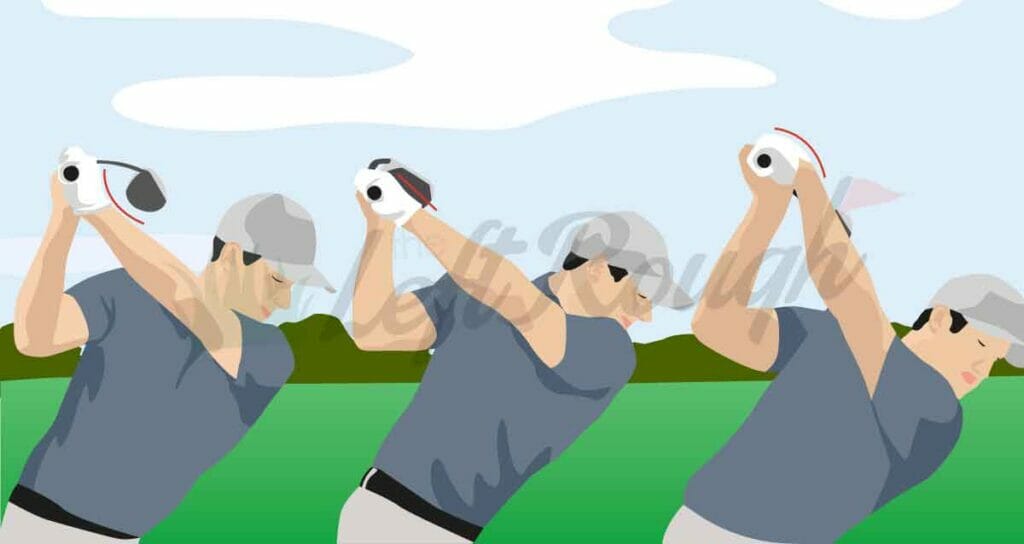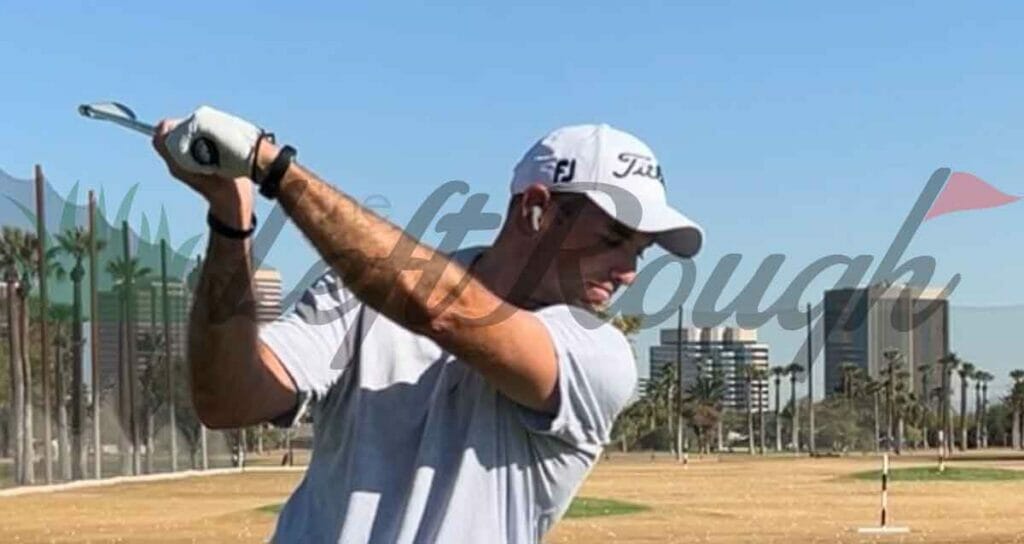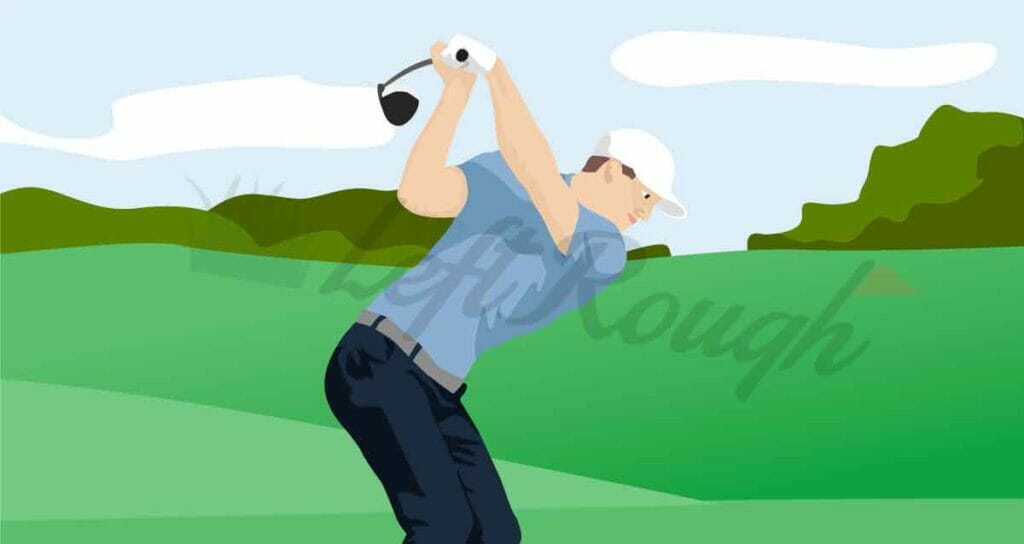Your wrist position can help or hurt your golf swing more than you might realize.
If you want to hit it longer, straighter, and overall become a more consistent ball striker, you need to evaluate your wrists. Since your hands are the only part of your body that connects to the grip, they play a massive role in shot shaping.
The problem is that most golfers have a bowed wrist or cup their lead wrist which can lead to hooks or slices. While most golfers should strive for a flat lead wrist position as it makes it easier to hit straighter shots.
But if you had to choose between a bowed wrist or cupped wrist, I’d argue the everyday golfer can benefit from bowing more. Keep reading to learn more about a bowed wrist and some techniques to improve your wrist position.
Bowed Wrist Golf 101
Having the correct wrist action in the golf swing is key to becoming a top-tier ball striker. But what is the right position for your wrists? How do you judge if you’re doing it right or wrong?
We’ll answer all of these questions and a lot more by the time you’re reading this article.
First, let’s identify the three common wrist positions in the golf swing.
The best to spot the position is by recording your golf swing and analyzing the top of the backswing. This isn’t something you can necessarily judge at address position or even impact position.
Once you pause the video to look at the top of your backswing, one of three things can occur with the left wrist (assuming you’re a right-handed golfer):
- Flat left wrist
- Bowed left wrist
- Cupped left wrist
Let’s break down each of these positions to figure out what is best for ball striking and what creates these positions.

Flat Wrist
The first position is known as a flat wrist and this is an ideal position to strive towards at the top of your backswing. If you need a good example of this, look no further than 15-time major champion Tiger Woods.
Known by many as one of the best iron players ever, his wrist angles are incredible. His left wrist matches his lead forearm and the club is in a picture-perfect position at the top of his swing. This makes it easy for him to unwind on the downswing and get his hands ahead of the ball at impact.
When the hands are ahead of the ball, this is known as forward shaft lean. It’s a position that most everyday golfers aren’t familiar with as most cup their wrists, which makes it nearly impossible to compress the ball.
The best way to create a flat wrist is with a neutral golf grip and on-plane takeaway. It’s definitely easier said than done but something to strive towards in your golf career.
Read our full article on the Flat Left Wrist here.
Cupped Wrist = Open Position
If you hit more slices than you care to admit, chances are you know what a cupped left wrist feels like. A cupped left wrist looks very different from a flat wrist at the top of the swing and typically leads to an open clubface.
When the wrist is cupping at the top of the swing, it leads to a lot of nasty pushes and slices. This happens because the club face is open and nearly impossible to square up at impact. It also tends to lead to a steep downswing and not the best contact either.
The number one cause of a cupped left wrist is a weak left-hand grip (for right-handed golfers). Fixing this issue can help golfers tremendously even if it feels awkward with a grip change for a few weeks.
To learn more about fixing a cupped wrist, click here for our full guide.
Bowed Position = Closed Position

The third position the wrist can get into is a bowed position which tends to create a closed clubface. In the beginning of this article I mentioned that most golfers would benefit from a bowed wrist vs. a cupped wrist.
Why you might ask?
Because a bowed lead wrist makes it easier to shallow the golf club and create an in to out swing.
When you shallow the golf club, not only do you make better contact but you also hit it straighter. In fact, you might even hit a slight draw that you’ve always wanted (instead of that pesky slice).
When you properly shallow the club, it’s easier to get the hands ahead of the golf ball at impact. This compression motion is a habit of elite players (both amateur and professionals) and not something that the average golfer does enough. If you hit it thin or fat and don’t make your divot ahead of the ball, chances are you know what I’m talking about.
Ben Hogan discusses the importance of bowing your wrist in his book, Five Lessons. Saying, “Every good golfer has his left wrist in a supinating position at impact. Every poor golfer does the exact reverse. As his club comes into the ball, he starts to pronate the left wrist – to turn it so the palm will be facing down.”
Let’s get into a few ways to change the left wrist so you have a bowing wrist or a flatter position at the top of your swing.

Change Your Grip
If you want to get a better wrist position, start by changing your grip. If you’re cupping it, then you’ll need a stronger grip. But if you’re bowing too much and starting to hit nasty hooks, you might need to weaken your left-hand grip.
While it’s better to have a bowed wrist than a cupped wrist in most cases, more isn’t always better. Since it creates a hook shot, it brings in a lot of trouble on the left side of the golf course.
Plus, as the old golf saying goes, “You can talk to a fade but you can’t talk to a hook.” If you’ve ever hit a snipe hook off the tee, chances are you know exactly what that saying means.
Use a Hanger Training Aid
There are a lot of training aids in the golf world and some of the most popular are wrist trainers. Since so many golfers struggle with this part of the swing, it’s never been easier to get instant feedback and improve.
Of all the devices out there, we love the Hanger training aid for a few reasons:
- Easy to use (no app)
- Helps you stop flipping
- Provides visual feedback
- Helps keep your swing on plane
- Small enough to keep in your bag
- Attaches easily to most grip sizes
Simply attach it to your grip and position it between your wrists. Thanks to the design you’ll get visual feedback on the clubface which helps improve your control and accuracy. A simple drill or two you can learn to keep the clubface square in your own swing fast.
Go here to read our full review of the Hanger Golf Training aid.
Get the Hackmotion Wrist Sensor
While the Hanger is great, it doesn’t have all the technology of the Hackmotion. If you’re a serious golfer who likes to learn from an app and even more feedback, this is the training aid for you.
The Hackmotion is a wearable device that makes it easy to learn your clubface position during the swing. Attach it to your wrist, put the sensor on your left hand (for right-handed golfers) and start swinging. It will sync up with the app and give you real-time data and auditory feedback as you hit golf balls.
It’s comparable to the deWiz golf watch but focuses specifically on wrist mechanics. They also give you drills to control the clubface and make it easy to track your progress over time. Learning about extension, flexion, and other terms that might confuse you has never been easier.
It’s easy to see why coaches and players love this device and why it was featured in Golf Digest. Check out the hackmotion golf sensor here.
FAQs About Wrists in the Golf Swing
Do you have more questions about the correct wrist position to make swing changes? If so, keep reading to learn some of the most frequently asked questions and answers.
What does a bowed wrist mean?
It means the club face is pointing in the direction of the sky. The easiest example of a top player in the golf world with this position is Dustin Johnson. He has one of the most noticeable bowed wrists but clearly it works well with his millions of career earnings.
What causes a bowed wrist?
The main cause of a bowed left wrist is a strong left hand on the grip. When you can see more knuckles on your left hand at address you’re much more likely to bow your wrist.
A little bit of bowing is okay and probably a good idea for most golfers as it makes it harder to hit a big slice. Since almost every golfer has battled a slice at one time or another, this can help straighten out your ball flight. Plus, hit it longer and make better contact with your irons.

What does a bowed left wrist do in the golf swing?
A bowed left wrist makes it easier to create a forward shaft and compress the golf ball.
Who plays with a bowed wrist in professional golf?
Some of the most noticeable examples are Dustin Johnson and Jon Rahm. Despite having a very short backswing, Rahm is able to generate an insane amount of power.
The reason?
His wrists. As a Golf.com article said, “Jon’s superpower comes from his wrists. Because he bows his left wrist at the top, he doesn’t need to worry about putting the club in the optimal “slot” on the way down — it’s already there!”
The article also mentioned that Jon struggles to extend his wrist and that’s why you will never see him cupped at the top of the swing. He uses what comes natural to him (aka, swings his swing).
Paired with the way he uses his strong lower body, Rahm creates a ton of power even with a shorter swing.
Is a bowed wrist good?
A slight bow is a good thing as it helps create a shallow move in the swing and straighten out ball flight. Since most golfers come over the top and hit a slice, this type of wrist action can help out tremendously to shoot lower scores. However, too much can lead to a hook.
Final Thoughts on a Bowing Wrist
If you had to choose between a cupped wrist or a bowed wrist at the top of your swing, a bowing position is better for your game. But too much of a bow can also cause some issues too.
Ideally, you want a flat lead wrist at the top of your backswing. This will make it easier to improve your accuracy and not suffer from huge misses in either direction.
To improve your wrist positions, use the drills and training aids mentioned above. If you’re changing your grip, just know it can take some time for it to feel normal but it’s worth the change.

